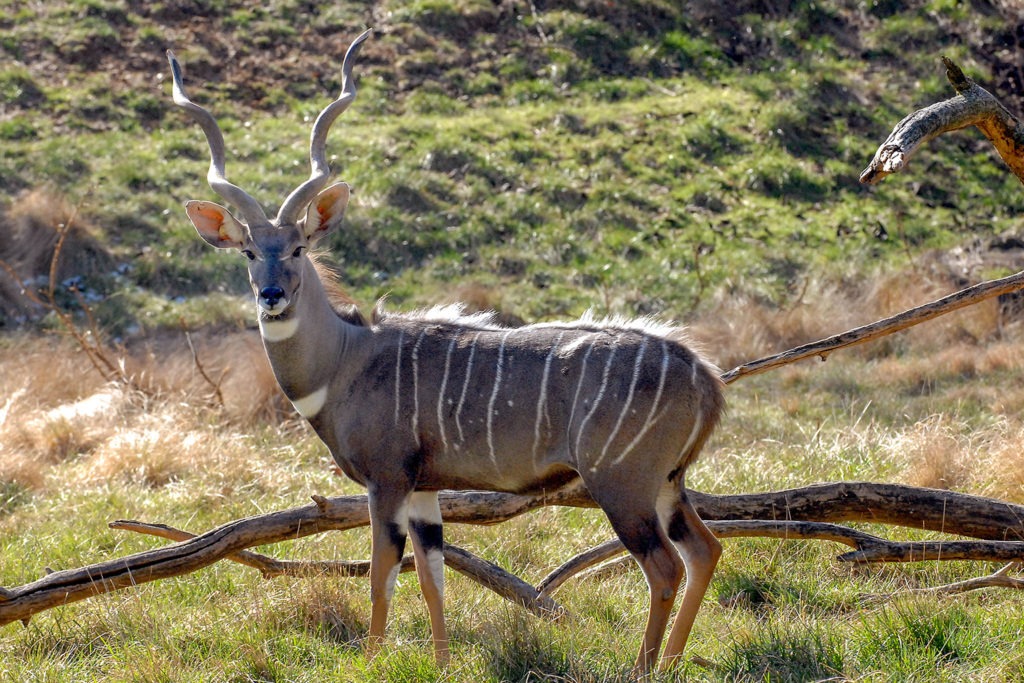Overview
“Where I live”
Lesser kudu live in dry, densely thicketed scrub and woodlands of northern east Africa. To see them at the Maryland Zoo, walk along the African Journey Boardwalk.
“How I live there”
Females tend to live in small groups of two or three, plus their offspring. Adult males, called bulls, are generally solitary. They leave their mothers after 1.5 to 2 years to be on their own and will join female herds only temporarily to mate. Bulls may have overlapping home ranges but are not aggressively territorial. When bulls cross paths, they usually resolve dominance issues quickly and peacefully by having a face-off that establishes who’s biggest.
Lesser kudu are active mainly at night and in the early morning hours, and seek shelter during the day. They browse mostly at dawn, feeding on the leaves and shoots of nearly 150 different plants! They rarely drink water and seem to get enough liquid from the plants that they eat. During dry seasons, for example, they will eat wild watermelons for the liquid they provide.
“Making my mark”
Given how many plant species they browse, lesser kudu certainly impact the ecosystem in which they live. As far as making their presence known to other animals, though, they’re much better off not making their mark because they are prey to many predator species!
Among lesser kudu, distinguishing males from females is easy. Females are reddish-brown and have no horns while adult males are blue-gray and have long, spiral horns.
“What eats me”
Leopards, lions, wild dogs, hyenas, eagles, and pythons will prey on lesser kudu and their young. Humans also hunt lesser kudu for their meat, hides, and horns.
Lesser kudu have large ears and excellent hearing to alert them to the presence of predators. When alarmed, they may make a loud barking call. If threatened, they will flee with their tails up. When standing still, they can be very hard to spot because the stripes on their bodies break up their outline and provide excellent camouflage.
Raising young
Adult males have shoving matches with each other to establish breeding rights. Males become sexually mature at about 1.5 years but won’t mate until they are socially mature around 4-5 years.
There is no fixed breeding season for lesser kudu so births occur throughout the year. Pregnancy lasts 7 to 8 months and usually results in the birth of a single calf. A female will leave her group to give birth and will keep her calf separated from the group for about the first month of life. The calf then begins to accompany its mother for longer and longer stretches of time, and is with its mother almost continuously by 3-4 months.
Survival is very difficult for young lesser kudu. About 50% of newborns succumb to disease or predation within the first six months of life. Calves grow rapidly and can live independently of their mothers after about 6 months, but only 25% will survive past their third birthday.
Conservation
Lesser kudu are listed by the IUCN, the world’s leading conservation organization, as “near threatened.” Lesser kudu populations are in decline in many parts of the species’ range, primarily because of disease, over-hunting, and habitat destruction by humans.
Taxonomy
- Kingdom: Animalia
- Phylum: Chordata
- Subphylum: Vertebrata
- Class: Mammalia
- Order: Artiodactyla
- Family: Bovidae
- Genera: Tragelaphus
- Species: imberbis


